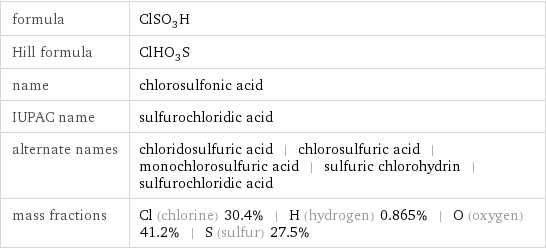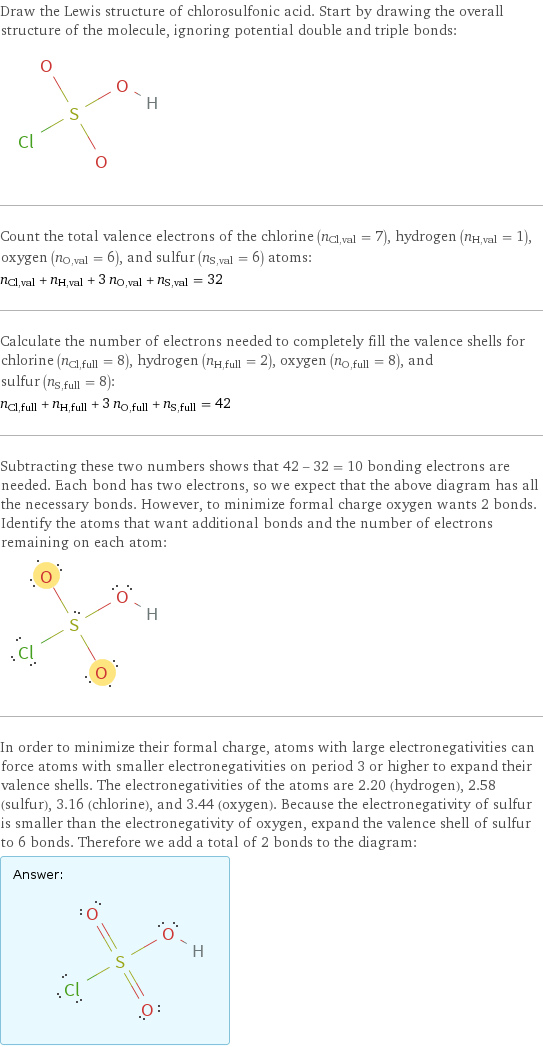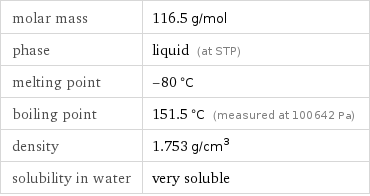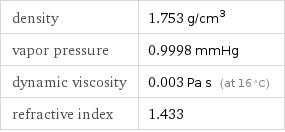Input interpretation

chlorosulfonic acid
Chemical names and formulas

formula | ClSO_3H Hill formula | ClHO_3S name | chlorosulfonic acid IUPAC name | sulfurochloridic acid alternate names | chloridosulfuric acid | chlorosulfuric acid | monochlorosulfuric acid | sulfuric chlorohydrin | sulfurochloridic acid mass fractions | Cl (chlorine) 30.4% | H (hydrogen) 0.865% | O (oxygen) 41.2% | S (sulfur) 27.5%
Lewis structure

Draw the Lewis structure of chlorosulfonic acid. Start by drawing the overall structure of the molecule, ignoring potential double and triple bonds: Count the total valence electrons of the chlorine (n_Cl, val = 7), hydrogen (n_H, val = 1), oxygen (n_O, val = 6), and sulfur (n_S, val = 6) atoms: n_Cl, val + n_H, val + 3 n_O, val + n_S, val = 32 Calculate the number of electrons needed to completely fill the valence shells for chlorine (n_Cl, full = 8), hydrogen (n_H, full = 2), oxygen (n_O, full = 8), and sulfur (n_S, full = 8): n_Cl, full + n_H, full + 3 n_O, full + n_S, full = 42 Subtracting these two numbers shows that 42 - 32 = 10 bonding electrons are needed. Each bond has two electrons, so we expect that the above diagram has all the necessary bonds. However, to minimize formal charge oxygen wants 2 bonds. Identify the atoms that want additional bonds and the number of electrons remaining on each atom: In order to minimize their formal charge, atoms with large electronegativities can force atoms with smaller electronegativities on period 3 or higher to expand their valence shells. The electronegativities of the atoms are 2.20 (hydrogen), 2.58 (sulfur), 3.16 (chlorine), and 3.44 (oxygen). Because the electronegativity of sulfur is smaller than the electronegativity of oxygen, expand the valence shell of sulfur to 6 bonds. Therefore we add a total of 2 bonds to the diagram: Answer: | |
3D structure

3D structure
Basic properties

molar mass | 116.5 g/mol phase | liquid (at STP) melting point | -80 °C boiling point | 151.5 °C (measured at 100642 Pa) density | 1.753 g/cm^3 solubility in water | very soluble
Units

Liquid properties (at STP)

density | 1.753 g/cm^3 vapor pressure | 0.9998 mmHg dynamic viscosity | 0.003 Pa s (at 16 °C) refractive index | 1.433
Units

Thermodynamic properties

molar heat of vaporization | 53.6 kJ/mol specific heat of vaporization | 0.46 kJ/g (at STP)
Chemical identifiers

CAS number | 7790-94-5 PubChem CID number | 24638 SMILES identifier | OS(=O)(=O)Cl InChI identifier | InChI=1/ClHO3S/c1-5(2, 3)4/h(H, 2, 3, 4)/f/h2H RTECS number | FX5730000 MDL number | MFCD00011523
NFPA label

NFPA label

NFPA health rating | 4 NFPA fire rating | 0 NFPA reactivity rating | 2 NFPA hazards | oxidizing agent | water reactive
Safety properties

flash point | -18 °C lower explosive limit | 3.3% (concentration in air) upper explosive limit | 37.7% (concentration in air)

DOT hazard class | 8 DOT numbers | 1754
Toxicity properties

RTECS classes | other